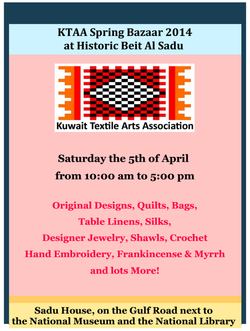
 Very excited to see all the beautiful textiles and handmade crafts, jewelry, bags, quilts and other items at the KTAA Spring Bazaar at the Sadu House in Kuwait City (near the National Assembly buidling and the National Library) on Saturday, April 5 from 10am to 5pm.
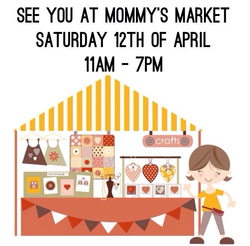 The next Mommy's Market will be held April 12 at the Lilly Center in Shuwaikh. There will be lots of shopping for moms, babies and children as well as games and activities for kids, street food, music and other exciting stuff happening. Check out the website to inquire about participating. 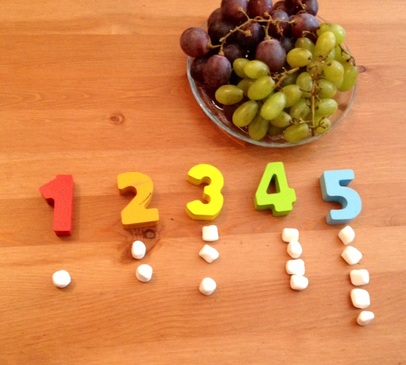 Kids in Kuwait fun with this simple learn through play counting game. Kids in Kuwait fun with this simple learn through play counting game. We're working on teaching our 2.5 year old her numbers (1-10) and how to count. Using the Hape woodcut numbers I got from Safat Home, I started with grapes but since she wasn't so interested, I switched to marshmellows (that got her attention!). I showed her the basic idea and then we counted them out together. We tried a few times and then switched up the game by placing the numbers in a different order. Of course she got to eat the marshmellows afterwards :) 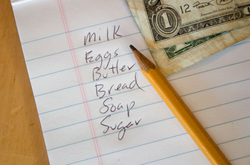 If you are like me, each time you head to the grocery you sit down and make out a list of all the stuff you need. Maybe you keep a running list in the kitchen or maybe you catalog the whole house each time. It's a chore I dislike as it takes up time and often I end up forgetting something we'll need later in week. Since my husband does most of the shopping but I make the lists, I needed a quick and easy way to keep us on the same page. The ultimate grocery shopping list is a free printable I found online. I chose one that is in Excel so you can edit it however you like to suit your own family's personal shopping requirements. (There are dozens online so you can search and find others if this one doesn't suit your family.) Each time you need to make a grocery run, just print out a copy and circle the items you need. Or you can print a copy, post it on the frig and each time you run out of something, circle it. Then when you are ready for the weekly shop, the list will be ready to go. Be sure to date the list each week so you can keep track of what you've bought and also compare over time to see just what your family is eating. Download the file (its an Excel spreadsheet) and edit as you like.
 Looking for something to do early Friday morning to get you motivated for the weekend? Want to keep it in the family and help model an active and healthy lifestyle for your children? Join the moms & kids workout class in Salmiya on Friday mornings for a family workout that that's healthy and fun. What: Moms & kids ( boys & girls both) get fit together. Work out with Nina at the Salmiya Sport Club (Pilates, boot camp and more) for moms and kids (from age 4+). When: Fridays from 8:15am to 9:15am Where: Al Salmiya Sport Club, Al Kansaa St. Block 3 (Kuwait Center for Diving) How much: KD 5 per class For more information Whats App: 6044-8673 or email: [email protected] 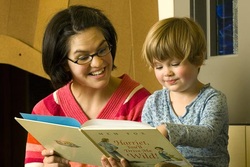 Learning ABCs is more than just repeating the song. Learning the phonics of the alphabet and how to blend letter sounds to read words are important steps in children's literacy development. Here are a few great tips for teaching young children to read. 1. Focus on the letters of her name. Names are the most important words for children, so it makes sense to begin literacy learning with the child’s name. Acknowledge the “child’s letter”—the first letter of his or her name—by pointing it out whenever and wherever you see it. Then do some letter scrambles using blocks, magnetic letters or letters on index cards. Mix up the letters of the child’s name and work together to put them back in the proper order. Repeat this often with your child’s name, and then introduce “Mom,” “Dad,” and the names of siblings, friends, family and pets. 2. Recognize each letter and know their sounds. It’s one thing for the child to know the letters in order, but it’s a bit harder for her to recognize each letter individually. When you see “her letter” on a sign, cereal box, or book, remember to point it out. Say, “Hey! Look here! I found your letter, Maddy! Here’s an M for Maddy. Mmmm, mmmm, Maddy!” Talk about the sounds that letters make and return frequently to easily relatable objects or things that interest the child. For example, say: “There’s a letter B for ‘blankie.’ I know you love blankie and sleep with it every night. Blankie begins with the letter B, like ‘ball’ and ‘butter’ and ‘baby bear.’ What else can you think of that begins with the B sound?” 3. Introduce uppercase and lowercase letters. Your child will not likely be reading books that have all uppercase letters, so it’s imperative that you talk about uppercase and lowercase letters early on. Play games that involve matching uppercase and lowercase letters and spell her name using both cases. 4. Practice early writing techniques. If children practice creating several simple letters, they will most likely be able to write the majority of the alphabet. Begin with X and O and then move on to a square and a triangle. Encouraging kids to “write” on sand, paint with water, or use their finger in shaving cream will make creating these shapes fun, and before you know it, they’ll be ready to move on to the letters of their names. 5. Connect objects with words. Because reading involves creating meaning by combining words, pictures and prior knowledge, early readers lean on illustrations when reading—and that’s okay. Label everyday objects and point to the word as you say it. Play games where children connect simple words with pictures, like “cat” with a photo of a cat and “dog” with photo of a dog, etc. Model how to do it by pointing out the first letter of the word and saying the sound that the word makes, followed by the word, and then pointing to the picture. 6. Practice print referencing. Print referencing is a simple yet meaningful way to enforce early literacy skills. It involves pointing out print elements in texts: pointing to the title of the book as you read it, running your finger under the words as you read the text on a page, or talking about anything related to the text. This helps children learn the basics: every book has a title and an author (and sometimes an illustrator), and we read from left to right, followed by a sweep down to the next line. Later, consider touching on basic grammar conventions and punctuation marks, differences between fiction and nonfiction texts, and different genres (news, magazines, poetry, short stories, etc.). 7. Read, read, read! Read with your child every day, many times a day. Read books, signs, posters—anything with words. Read in the morning, in the afternoon, and at night. Read at the park, in the living room, at the pool. Read print everywhere you can find it! http://www.pbs.org/parents/education/reading-language/reading-tips/learning-to-read/ 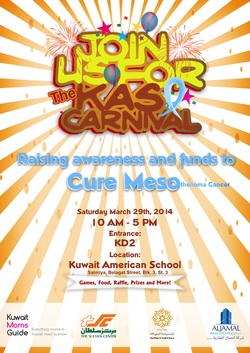 Very excited to be the media partner for the Kuwait American School's upcoming Carnival to raise awareness and funds for Mesothelioma research. The carnival will include fun, games, activities, painting, competitions, exhibits and much more. Please drop by from 10am to 5pm on Saturday, March 29 and be sure to say hi to Kuwait Moms Guide and sign up for a free copy of the next Kuwait Moms Guide. KD 2 entrance. What: KAS Carnival When: Saturday, March 29 from 10am - 5pm. Where: KAS Campus, Salmiya, Blagat Street, Block 3, Street 3. (Just behind Naif Chicken) 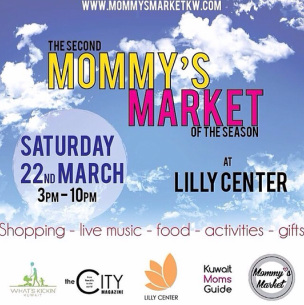 Lots of shopping, baby clothes and gifts, activities, games, street food, cakes, gifts, live music, children's play area and relaxing area for moms at this weekend's Mommy's Market. Check it out at the Lilly Center in Shuwaikh from 3pm to 10pm and be sure to pass by and say Hi to Kuwait Moms Guide. We hope to see you there! p.s. See map below for directions to the Lilly Center. Its located in Shuwaikh Industrial Area on Sixth Street. Take the first right after City Center if you are on the Jahra Road and it will be on the corner across from Tilal Complex. |
Archives
February 2019
|
||||||
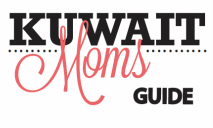

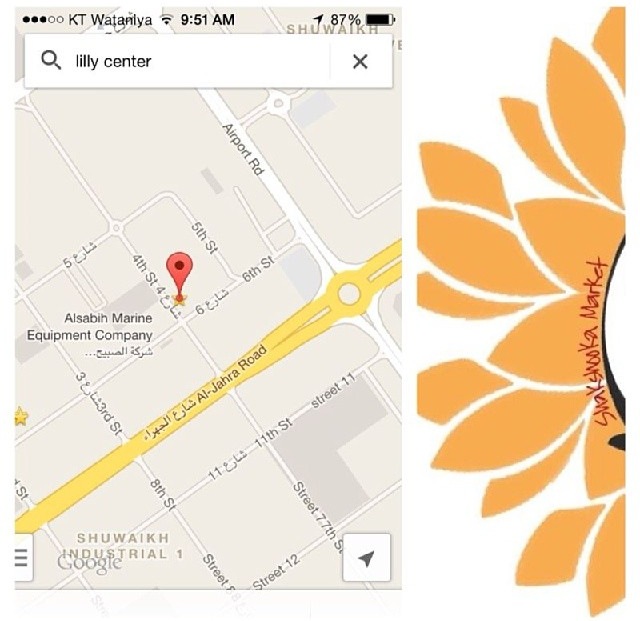

 RSS Feed
RSS Feed
